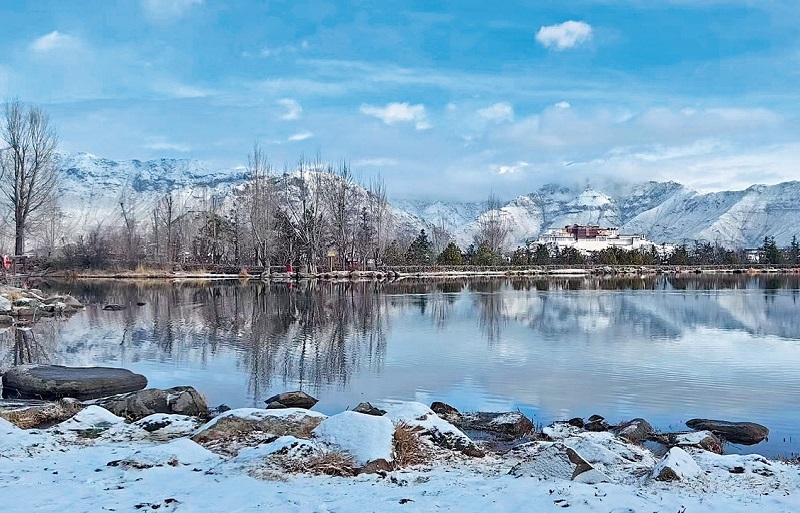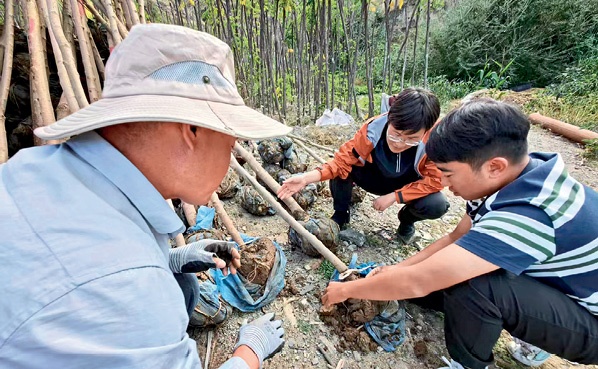
A winter view of Lhasa’s Southern Mountain Park. Tashi Chophel
This year’s March 21 marks the 13th International Day of Forests. Afforestation is an effective way to deal with climate change; it helps restore the balance of the ecosystem while also providing support for the economic development of local communities. As the first ecological restoration project of large-scale mountain afforestation in Xizang Autonomous Region, the greening project of the barren mountains on both sides of the Lhasa River has pioneered a new model of ecological restoration which is tailored to local conditions and empowered by technology. By so doing, it has worked wonders in high-altitude areas. The once barren mountains on the plateau are now coming alive with green vitality.
Local Forest Rangers
Lhasa has hired a large number of forest rangers. “My work includes tree management and fire prevention. The work keeps me busy every day, giving me quite a sense of fulfillment,” said Tashi Chophel, one of the forest rangers working in the southern mountain park. Every morning he begins his work in the park, which is nearly 4,000 meters above sea level, by conducting a routine inspection and watering the saplings one by one. “The steep slope and loose soil make it particularly difficult to water,” he said. “Back when I first began planting saplings on the hillside, I walked over five kilometers every day to check on each sapling.”
As a result of his dedicated work, Tashi Chophel has witnessed the once barren mountain, where strong winds blew around the yellow sand, transformed into a lush green one. “See, that tree I planted with my own hands three years ago now has branches spreading out like an open umbrella ,” he said proudly. He also recorded twittering birds and precious white-lipped deer that live in the forest with a drone and a mobile phone. Today, the area has become a haven for wild animals as a result of its improving regional ecosystem.
A Dedicated Team of Experts
“Planting a tree here in this environment is ten times harder than on the plain,” Pu Luo, a technician from the Forestry Investigation and Planning Institute of Xizang Autonomous Region said. “As the designer of the greening project, our team first had to overcome oxygen deficiency in high-altitude areas. With the help of drones, we managed to reduce the planting process of saplings from several hours of labor to just a few minutes,” he said.
During the designing process, the team used such remote sensing technology as drones and ground survey methods that included soil detectors to probe into slopes located at an altitude of over 3,600 meters. The team created an afforestation map based on the sunlight, soil, and humidity at different altitudes. For elevations between 3,650 to 3,900 meters, a composite planting structure which focuses on growing arbors as the main vegetation with shrubs as a supplement was adopted. For 3,900 to 4,100 meters, shrubs were prioritized with herbaceous plants as a supplement. For areas above 4,100 meters, natural restoration combined with artificial sowing and aerial seeding is preferred.
“Through long-term experimentation and observation, we have selected more than 30 species of trees that are suitable for planting in high-altitude environments. We have also gained valuable experience in afforestation in rocky mountains at altitudes reaching from 3,600 to 4,100 meters, creating a green miracle in alpine mountains. What’s more, we’ve also established the first plateau seed bank in Xizang to preserve more than 200 plateau plants for subsequent ecological restoration,” he said. Such a layout can help ensure the stability of the ecosystem while at the same time maximize the greening benefits.
Since the greening project was launched, nearly 466.7 square kilometers of afforestation have been completed, with the overall survival rate reaching over 85 percent. The innovative, technology-driven practices tailored to local conditions have greatly helped the project achieve fruitful results as well as established a reference for high-altitude ecological restoration.

Yin Peifeng (middle), Party secretary and vice director of Lhasa Forestry and Grassland Bureau, inspects seedlings with two co-workers in the park. Photo courtesy of Lhasa Forestry and Grassland Bureau
Green Development for Both Man and Nature
Through continuous practice during recent years, Lhasa has accumulated a set of ecological restoration solutions applicable in other high-altitude areas. “The project integrates technological assistance, engineering management, official guarantees, and public supervision to govern the quality of seedlings, construction technology, and protection management. It also implements inspections of soil improvement, seedling quality, and planting technology, and acceptance checks of the construction quality, survival rates, and management effectiveness. All of this is done in order to improve the quality and efficiency of the project,” said Yin Peifeng, Party secretary of Lhasa Forestry and Grassland Bureau.
In terms of public participation, Lhasa has established a shareholder mechanism for joint contribution and shared benefits. By creating labor cooperation organizations and public welfare positions for forest protection, and recruiting full-time rangers, it encourages local farmers and herdsmen to participate in the afforestation process. Over the past three years, the greening project has provided jobs for more than 7.2 million local people, achieving a labor income of over RMB 2.5 billion. The ecological industry has provided many people with stable income and helped the region achieve both ecological progress and livelihood improvement.
“The long-term greening project aims to complete within 10 years a total of 1,378.1 square kilometers of green land. This is equivalent to the construction of more than 600 new southern mountain parks. We make targeted goals for each area annually to ensure the steady and orderly progress of the project,” Yin said.
After the project is completed, it is expected to add 49.8 million tons of water storage, 229,100 tons of carbon sequestration, and 193,000 tons of oxygen release annually. Integrated with the concept of ecological priority, the green development path that Lhasa is exploring will greatly enhance ecological, economic, and social benefits, instrumental to both humans and nature.